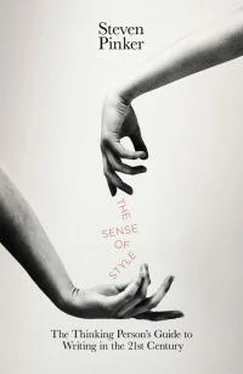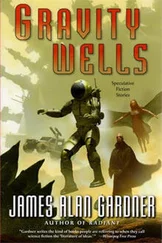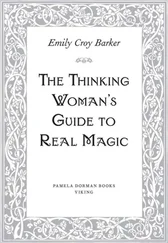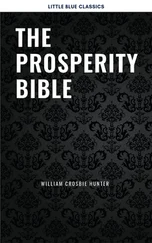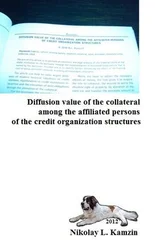Similarity and contrast link two propositions that are similar in most ways but different in at least one way. They call the reader’s attention either to the similarities or to the difference. These relations may be conveyed without even using a connective word: all the writer has to do is write the statements using parallel syntax and vary only the words that indicate the difference. Unfortunately, many writers blow the opportunity and capriciously vary their wording as they compare two things, a pernicious kind of synonymomania which flummoxes the reader because he doesn’t know whether the writer is directing his attention to the difference between the contrasting things or to some difference between the synonyms. Imagine that O’Connor had written Herons are opportunistic hunters, but great blues defend a fishing hole even when it’s frozen. The reader would wonder whether it’s only great blue herons that defend frozen fishing holes, or all herons.
It’s always surprising to me to see how often scientists thoughtlessly use synonyms in comparisons, because the cardinal principle of experimental design is the Rule of One Variable. If you want to see the effects of a putative causal variable, manipulate that variable alone while holding everything else constant. (If you want to see whether a drug lowers blood pressure, don’t enroll your participants in an exercise program at the same time, because if their blood pressure does go down, you’ll never know whether it was the drug or the exercise.) Parallel syntax is just the Rule of One Variable applied to writing: if you want readers to appreciate some variable, manipulate the expression of that variable alone while keeping the rest of the language unchanged. On the left below are two examples—the first expressing similarity, the second expressing contrast—in which scientists do in their prose what they would never do in the lab. On the right are the more rigorously controlled alternatives:
In the ten nations with the largest online populations, non-domestic news sites represent less than 8% of the 50 most visited news sites, while in France, 98% of all visits to news sources are directed to domestic sites.
In the ten nations with the largest online populations, non-domestic news sites represent less than 8% of the 50 most visited news sites; in France, the figure is just 2%.
Children’s knowledge of how to use tools could be a result of experience, but also object affordances defined by shape and manipulability may provide cues such that humans do not require much time experimenting with an object in order to discover how it functions.
Children’s knowledge of how to use a tool could be a result of their experience with the tool; alternatively, it could be a result of their perceiving the tool’s affordances from shape and manipulability cues.
The first sentence, which says that most Internet users go to news sites in their own country, subverts its attempt to express a resemblance relation in three ways. It inverts the syntax ( news sites represent versus visits to news sources ), it flips the measurement scale (from the percentage of visits to non -domestic sites to the percentage of visits to domestic sites), and it uses a connective that is perversely ambiguous. If while is used in a temporal sense (“at the same time”), it implies similarity; if it is used in a logical sense (“although”), it suggests contrast. Rereading the passage a few times reveals that the authors meant similarity.
The second example also trips over its message. It upends the syntax from one proposition to the other ( Children know how to use tools from experience and Object affordances provide cues [to children about tools] ), and it uses the connective also in a confusing way. Also implies similarity or elaboration (another resemblance relation, which we’ll get to soon), and the author uses it here to mean that there are at least two hypotheses for how children know how to use tools (rather than the single hypothesis that they know from experience). But he is actually trying to contrast the two hypotheses, so also pulls the reader in the wrong direction (the author presumably chose it because there is “also” another hypothesis on the table for scientists to consider). The author seems to realize the problem as he proceeds, so he tacks on such that to signal that he is contrasting the two hypotheses after all. But it would have been better to rewrite the sentence to convey the contrast from the start, using an unambiguous connective such as alternatively . ( Affordance, by the way, is a psychologist’s term for the aspect of an object’s appearance that suggests what you can do to it, such as its liftability or its squeezability.)
Similarity and contrast are not the only resemblance relations. In elaboration, a single event is first described in a generic way and then in specific detail. Then there are four relations that fall into two neat pairs, depending on which event the author wishes to mention first. There’s exemplification (a generalization, followed by one or more examples) and generalization (one or more examples, followed by a generalization). And there’s the opposite, exception, which can be introduced either generalization first or exception first.
Coherence Relation
Example
Typical Connectives
Elaboration
Herons have one thing in their favor: they are total opportunists.
:
(colon),
that is, in other words, which is to say, also, furthermore, in addition, notice that, which
Exemplification
Herons are total opportunists. When the fish are frozen out, they’ll eat other things, including crustaceans, mice, voles, and small birds.
for example, for instance, such as, including
Coherence Relation
Example
Typical Connectives
Generalization
When the fish are frozen out, herons will eat other things, including crustaceans, mice, voles, and small birds. They are total opportunists.
in general, more generally
Exception: generalization first
Cape Cod winters are often mild and pleasant. Then there is this winter, the winter that never ends.
however, on the other hand, then there is
Exception: exception first
This winter seems like it will never end. Nonetheless, Cape Cod winters are often mild and pleasant.
nonetheless, nevertheless, still
The second of Hume’s family of relations is contiguity: a before-and-after sequence, usually with some connection between the two events. Here, too, the English language gives us the means to mention the events in either order while holding the meaning constant.
Coherence Relation
Example
Typical Connectives
Sequence: before-and-after
The cold weather arrives and then the herons head south.
and, before, then
Sequence: after-and-before
The herons head south when the cold weather arrives.
after, once, while, when
The language gives writers a second way of controlling the order in which two events are mentioned. Not only can they choose between before and after, but they can also choose whether to prepose a temporal modifier or leave it in its place: After the cold weather arrives, the herons head south versus The herons head south after the cold weather arrives .
But here the language may be a bit too clever for its own users. Though English cleanly distinguishes the order in which two things happened in the world from the order in which they are mentioned in a text, English speakers tend to be more concrete, and naturally assume that the order in which events are mentioned is the order in which they took place (as in the old wisecrack They got married and had a baby, but not in that order ). All things being equal, it’s good for a writer to work with the ongoing newsreel in readers’ minds and describe events in chronological order: She showered before she ate is easier to understand than She ate after she showered. For the same reason, After she showered, she ate is easier than Before she ate, she showered. 12 Of course, things are not always equal. If the spotlight of attention has been lingering on a later event, and now the writer must introduce an earlier one, the imperative to mention given before new trumps the imperative to mention early before late. For example, if you had been staring at the wet footprints leading to the breakfast table and were seeking an explanation, it would be more helpful to hear Before Rita ate, she showered than After Rita showered, she ate.
Читать дальше
